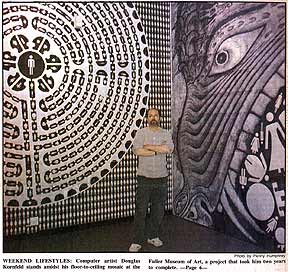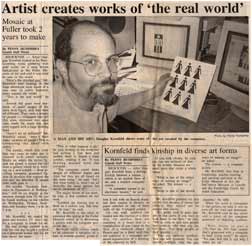.
Artist Creates works of 'The Real World'
Mosaic at the Fuller took 2 years to make.
(Front Page) Sunday, May 13, 1995
By Penny Humphrey, Staff Writer

Brockton - Artist Douglas Kornfeld looked at his floor-to-ceiling mural glittering with gold mylar on a deep brown background at the Fuller Museum of Art and said it was what he sees in the world.
" Here's the standard guy," Mr. Kornfeld said looking at the huge stereotype stick figure of a man seen on the bathroom doors around the world. "This is the real world," he said.
Around the giant were hundreds of small figures, only they were all different. They were a mosaic of people - elongated into tall thin ones, shortened into squat ones, made fat, made thin, and even topped with a large bobbing head.
" Arenít we all different?" Mr. Kornfeld asked. "Aren't there many varieties of people? This is comparing the ideal with reality."
The mosaic, which took two years to make and is created with small wooden blocks on which the mylar figures are glued, is across the hall from a gallery where he is working on a new exhibit - floor-to ceiling computer generated figures in mosaics that capture the eye and attention of people who walk past it.
His exhibit, "Symbols: Pathways to Damnation and redemption," will be on display through June 25. He can be found working on the exhibit Wednesdays, Fridays, Saturdays and Sundays from 1 p.m. to 5 p.m. Mr. Kornfeld, 40, traded his paint and brushes 2-1/2 years ago for a computer to create his art. He had always painted symbols but one day he put a symbol on a computer screen and his art was never the same.
" This is what inspired it all," he said, turning to his computer and pulling a line here and another there to distort a male symbols, making is fat. "I was fooling around with the computer."
" The computer could make people all different shapes and sizes but they are all based on the same thing," he said. "Isn't that what reality is? Aren't we all basically the same person but we're variations of it?"
The major theme of his work, he said, is that symbols do not work.
" Symbols are forcing you to think in a certain way that may not be true." he said.
Mr. Kornfeld is the artist-in-residence this spring at the Fuller Museum where he is filling a gallery with his computer produced art.
He works while visitors watch as he produces a variation of a man or woman symbol, prints it, cuts it out with an Exacto blade and then staples it directly to one of three walls of the U-shaped gallery.
On one wall, symbols are loaded into the replica of a slave ship. On another, they are marching in a maze that is a reproduction of one found on the floor of a medieval church in France and on the third wall they are scattered in a computer produced reproduction of a drawing of the entrance to hell.
Mr. Kornfeld pointed out that on the first mosaic, if slaves had identity they would not be treated like slaves. "Its pretty hard to pack people in like cattle if you had to look at them in the face," he said. "But as soon as you turn people into symbols why then you can kill them. You strip people of their identity. You can enslave symbols. You can kill symbols. You can march symbols into the gas chamber," he said.
When his work is completed in the gallery, he said, it will be torn off the wall and destroyed. Mr. Kornfeld said he has never sold a piece of his computer art depicting symbols. "Who wants to put a 13-1/2 foot by 26-1/2 foot mosaic that's generated with a computer in their living room?" he asked. "No one. But this is not why I make my art."
